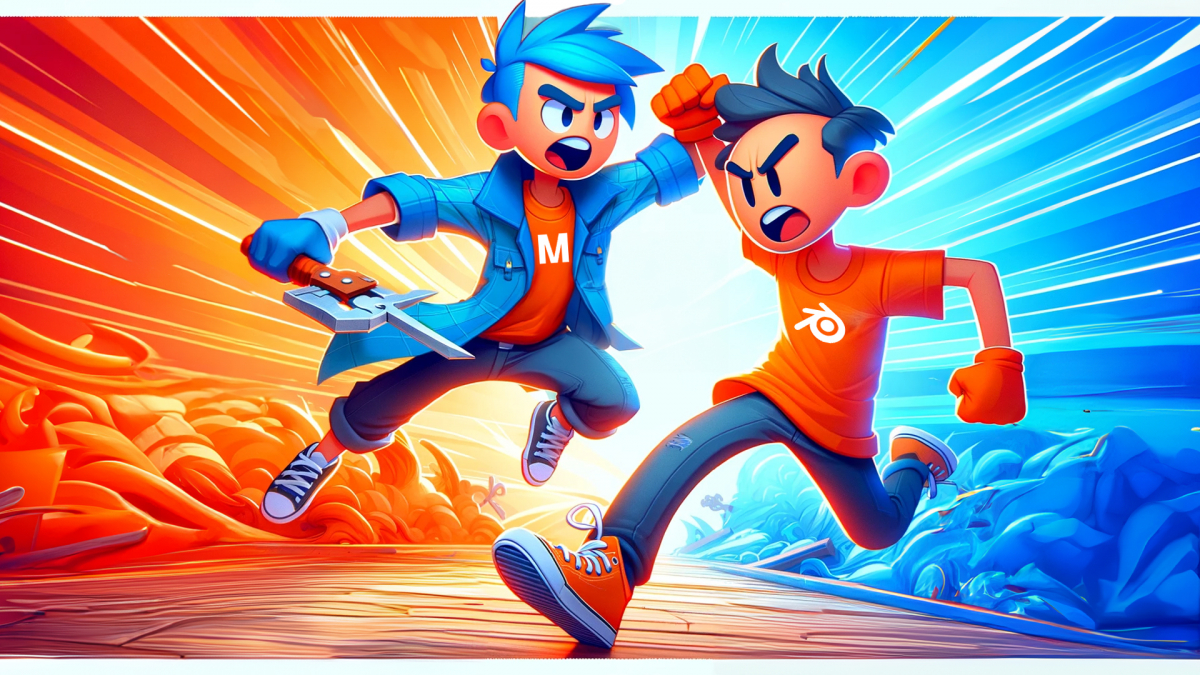Pricing: Blender Takes the Lead
Exploring your 3D assets for the web and counting your pennies? Blender's your go-to!
On the other hand, Maya, developed by Autodesk, comes at a hefty price. It costs $1,875 per year, and additional 3D packages can cost an extra $800.
Not everyone can afford Maya, making Blender the clear winner in terms of pricing.
With its open-source generosity and a free license, it outshines Maya's high-cost per year price tag. Budget-friendly? Blender triumphs!
Modeling: Blender vs. Maya
In the riveting world of 3D assets for the web, Blender and Maya showcase their unique strengths, creating a captivating showdown between digital maestros.
Blender
Blender, the fast and skilled 3D asset for the web, amazes with magical creations at the click of a button.
Maya
Maya, on the contrary, carefully plans moves to create a stunning reveal with expert shading.
As the creator, you decide how things go – do you like Blender's quick style or Maya's detailed brilliance?
It's not a serious competition, just a friendly choice where you pick what you enjoy. In this exciting 3D character models showdown, the stage is yours to craft a masterpiece that suits your digital world.
Rendering: Blender's Advantage
Blender impresses with its captivating style. Meanwhile, Maya shows off strength and memory efficiency with its powerful engine, Arnold.
However, a glitch in Maya with preloading sometimes freezes the software, taking away some of its shine.
Meet Blender, the trendsetter, using its EV rendering engine like a key to instant magic. Your 3D assets for VR will come to life quickly, boosting your work speed.
But the magic doesn't end there – Blender's high-quality renders create really great frames to make everything look super real.
This showdown isn't just about muscle; it's a tale of flexibility and optimization. Maya deals with loading issues, but Blender steps up, all set to enhance your 3D character models in the spotlight.
Animations: Blender vs. Maya
Imagine you're a game developer, on the brink of breathing life into your cartoon 3D character. Here's the thrilling plot twist: both Blender and Maya have their ace cards.
Blender
Blender comes forward, bringing a bunch of animation options. Picture this – you're like the puppet master, pulling strings in different creative setups, enjoying the freedom to do whatever you want.
Maya
Now, enter Maya, the luminary of film studios. It's the go-to for the big screens, armed with advanced animation tools and built-in rigs that make Hollywood hearts skip a beat. And if you're fluent in Maya's scripting language, brace yourself for animations that redefine wow.
Now, let's talk about Blender again and its cool features. Imagine 2D animations blooming in a 3D world, a perfect canvas for artists creating storyboards with skill.
In the big animation face-off, Maya takes the lead, showing off its toolbox and special add-ons that grab all the attention.
Visual Effects:Maya's Specialization
Maya is really good at making fake lava and concrete look real, using its special tool with amazing skill.
But get ready for Blender – it comes in with its own magic, creating dust storms and blizzards, painting a cinematic picture like nothing else.
However, Maya takes the lead in visual effects. Why? Well, Maya has a bunch of cool plugins for visual effects, something not so common in Blender's open-source world.
With plugins like fume FX, phix FD, and caraca fuming, Maya creates a mix of effects that makes it the clear champion in the visual effects realm.
Usability: Blender's Versatility
Embark on the usability adventure, where Blender steals the spotlight with its versatility.
Choosing 3D assets for UI? Get ready for a fun ride with Blender – it's about opening lots of windows and managing different tasks all at the same time. It's easy, smooth, and designed to fit your creative ideas.
Now, think about Maya, a bit limited in the window-opening party because it uses a lot of resources.
On the other hand, Blender, with its open-source style, becomes the master of ease, perfect for handling lots of users multitasking at the same time.
Updates and Learning Curve
Now, let's talk about updates and the learning curve rollercoaster.
Blender is the trendsetter, showering you with frequent updates and an ever-growing list of features. Yes, it can be a challenge to keep pace, but oh, the productivity gains are worth the ride.
On the flip side, meet Maya—consistent, stable updates that follow a reliable schedule. But here's where Blender pulls another trick from its hat—tutorials galore, an online library catering to both beginners and pros.
Maya has its tutorial charms, but it can't quite beat the vast wisdom you'll find in Blender's tutorial wonderland. When it comes to updates and learning, Blender is the champ, ensuring a journey of constant improvement and a treasure trove of knowledge.
Conclusion
Explore the 3D world wisely– the choice between Blender and Maya is a saga tailored to your needs and project vibe.
Blender vs. Maya: Final Comparison
Introducing Blender, the perfect start for beginners and creative fans. With its free access, easy-to-use appeal, and loads of tutorials, it's like your pass to a 3D cartoon world always growing.
Now, meet Maya – the experienced hero of movie studios, steady and respected in animation and visual effects. Packed with advanced tools and compatibility with plugins, it's the choice for pros creating cinematic wonders.
Bottom Line
Each has its own perks, and the choice is yours, based on what you like and your project needs. Explore our collection of 3D character models to enhance your creative journey.
If this blog resonated with your 3D interests, give it a thumbs up for some valuable insights, and get ready for more creative tips. Your adventure is just starting, and we're excited to be a part of it. To watch a more detailed comparison between Blender and Maya, please click here.



